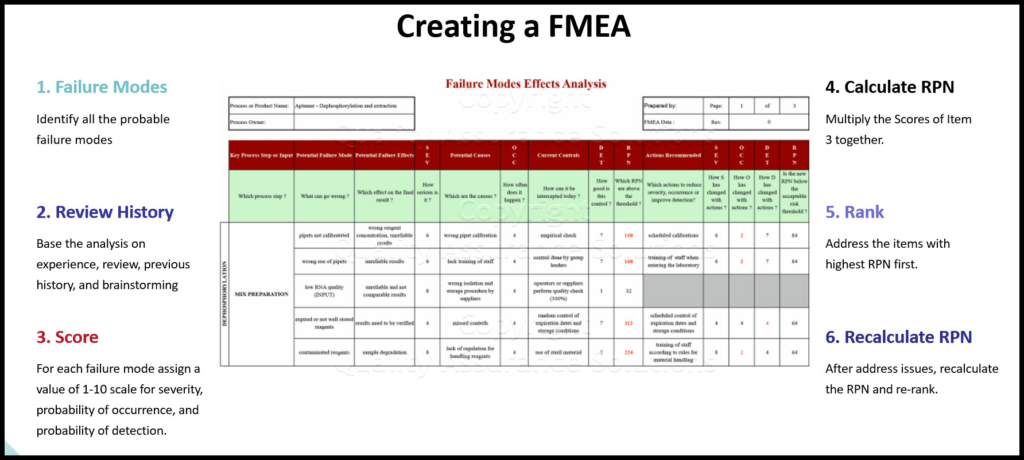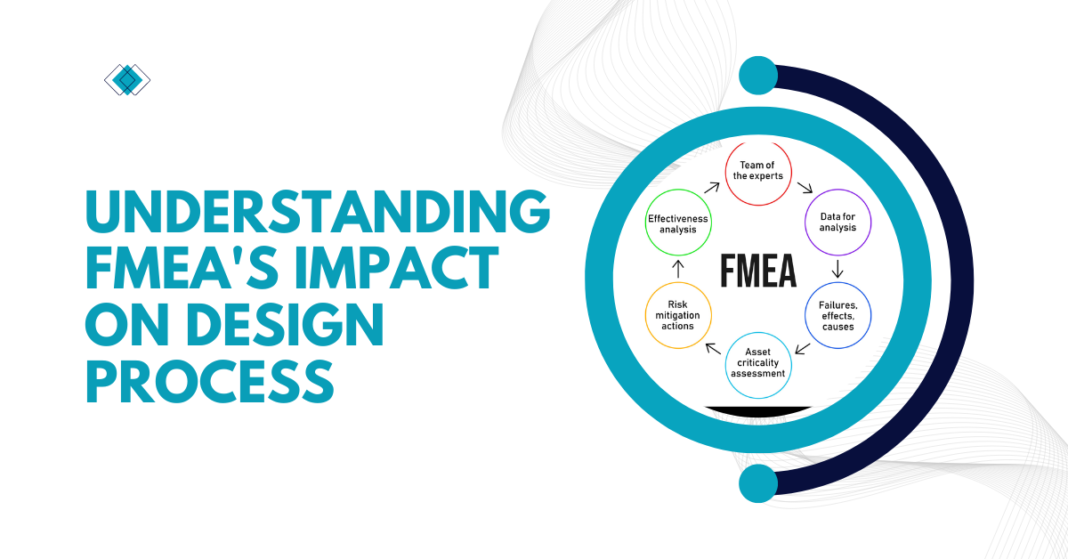Failure Mode and Effects Analysis (FMEA) is a structured approach used to identify and evaluate potential failures in a product, process, or system. By anticipating where things could go wrong, teams can develop strategies to mitigate risks and improve the overall design process. FMEA is particularly valuable for third-party suppliers in the software industry, as it helps them understand how their products interact with others and ensures that they meet quality standards. In this article, we will explore the critical role of FMEA in the design process, focusing on its benefits, implementation steps, and best practices.
Understanding FMEA: A Brief Overview
FMEA is a proactive methodology used to assess potential failure modes within a design. It involves examining each component or process step to determine how it might fail, the consequences of that failure, and the likelihood of its occurrence. The analysis prioritizes failure modes based on their severity, occurrence, and detection ratings, allowing teams to focus on the most critical issues first.
In the context of software design, FMEA helps identify risks related to functionality, security, usability, and performance. By evaluating potential failures early in the design process, teams can implement corrective actions before problems arise, saving time and resources in the long run.
Note – If your organization is looking to enhance product quality and mitigate risks in the design process, consider integrating failure mode and effects analysis into your workflow. By proactively identifying potential failures, your team can ensure reliable software solutions that meet customer expectations. For expert guidance on implementing failure mode and effects analysis tailored to your specific needs, reach out to DDSPLM today. Elevate your design process and deliver exceptional results with the power of FMEA.
Importance of FMEA in Software Design
The software industry is characterized by rapid changes and constant innovation. As a result, the complexity of software systems can lead to unforeseen issues that may impact performance and user satisfaction. This is where FMEA comes into play.
By applying FMEA during the design process, software teams can systematically identify potential problems and address them before they escalate into critical failures. This not only enhances product quality but also boosts customer confidence. When clients know that a thorough risk assessment has been conducted, they are more likely to trust the software being provided.

Steps to Implement FMEA in the Design Process
Implementing Failure Mode and Effects Analysis in the design process involves several key steps. Each step plays a crucial role in ensuring a comprehensive analysis and effective risk management.
Step 1: Assemble a Cross-Functional Team
The first step in implementing FMEA is to gather a diverse team of experts from various fields. This team should include software engineers, designers, quality assurance professionals, and any other relevant stakeholders.
The team should meet regularly to discuss the design, share insights, and identify potential failure modes. Collaboration is essential, as it allows team members to leverage their expertise and experience, leading to a more thorough understanding of the software and its potential weaknesses.
Step 2: Define the Scope and Objectives
Once the team is assembled, the next step is to define the scope of the FMEA.
For software design, the scope might include specific modules, features, or interactions within the system. Clearly defining the objectives helps the team stay focused and ensures that the analysis is relevant and actionable.
Step 3: Identify Potential Failure Modes
With the scope defined, the team can begin identifying potential failure modes. This step involves brainstorming sessions where team members consider how each component or process could fail.
For example, if the software includes a login feature, potential failure modes might include incorrect password handling, security vulnerabilities, or poor user experience during the login process. Documenting these failure modes is crucial, as it forms the foundation for the rest of the Failure Mode and Effects Analysis process.
Step 4: Evaluate the Effects of Each Failure Mode
After identifying potential failure modes, the team must evaluate the effects of each failure. This involves considering the impact of a failure on the user and the overall system.
For instance, if a login feature fails, the consequences could range from user frustration to a significant security breach. By assessing the severity of each effect, the team can prioritize which failure modes require immediate attention.
Step 5: Assess the Likelihood of Occurrence and Detection
Next, the team needs to assess the likelihood of each failure mode occurring and the ability to detect it before it reaches the user. This involves assigning ratings based on historical data, expert judgment, and experience.
The combination of these ratings helps identify critical areas where preventive actions are necessary.
Step 6: Prioritize Failure Modes
Once the team has evaluated the severity, likelihood of occurrence, and detection, the next step is to prioritize the failure modes. Prioritization allows teams to allocate resources effectively and focus on the most critical issues.
Benefits of Using FMEA in the Design Process
Integrating Failure Mode and Effects Analysis into the design process offers several significant benefits. These advantages contribute to better product quality, reduced costs, and improved customer satisfaction.
Improved Product Quality
By identifying potential failure modes early in the design process, teams can implement corrective actions that enhance product quality. Addressing issues before they escalate results in a more reliable software product, reducing the likelihood of defects and performance problems.
Cost Savings
FMEA can lead to substantial cost savings over time. Preventing issues during the design phase is often more cost-effective than addressing them later in the development cycle or after deployment.
Enhanced Customer Satisfaction
When software products are of high quality and perform as expected, customer satisfaction naturally increases. By utilizing FMEA, teams can deliver reliable and user-friendly software that meets or exceeds customer expectations. Satisfied customers are more likely to return for future business and recommend the software to others.
Strengthened Collaboration
The collaborative nature of FMEA encourages communication and teamwork among diverse stakeholders. By involving different experts in the analysis, teams can share knowledge and insights that contribute to a more robust design process. This collaboration fosters a culture of continuous improvement within the organization.
Best Practices for FMEA Implementation
To ensure the successful implementation of FMEA in the design process, teams should follow some best practices that enhance the effectiveness of their analysis.
Document Everything
Thorough documentation is essential throughout the FMEA process. Documentation also serves as a reference for future projects, allowing teams to learn from past experiences.
Review and Update Regularly
FMEA is not a one-time activity; it should be an ongoing process.
Train Your Team
Investing in training for team members involved in FMEA can significantly improve its effectiveness. Providing education on FMEA principles, methodologies, and tools empowers teams to conduct thorough analyses. Training fosters a shared understanding of the importance of proactive risk management in the design process.
Use FMEA Software Tools
Leveraging specialized FMEA software tools can streamline the analysis process. These tools often come with templates, reporting features, and collaboration capabilities that enhance efficiency and organization. Using software can also help teams maintain consistency in their FMEA efforts.
Conclusion
Failure Mode and Effects Analysis (FMEA) plays a crucial role in the design process, especially in the software industry. By systematically identifying potential failures and their effects, teams can proactively address issues that could impact product quality and user satisfaction. Implementing FMEA involves several key steps, including assembling a cross-functional team, defining the scope, identifying failure modes, evaluating their effects, and prioritizing them based on risk.
The benefits of using Failure Mode and Effects Analysis are numerous, ranging from improved product quality and cost savings to enhanced customer satisfaction and strengthened collaboration. By following best practices such as thorough documentation, regular reviews, team training, and utilizing FMEA software tools, organizations can maximize the effectiveness of their FMEA efforts.
In a fast-paced industry where software products are constantly evolving, adopting FMEA as a core part of the design process is essential for success. By prioritizing proactive risk management, software teams can deliver high-quality solutions that meet the needs of their clients while minimizing the likelihood of critical failures.
For more insightful articles related to this topic, feel free to visit coknews.com




